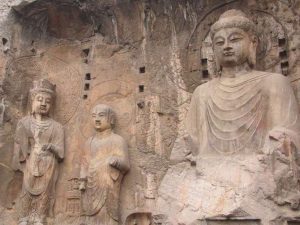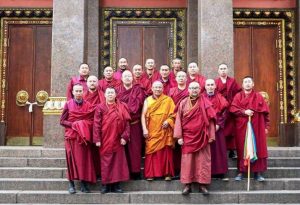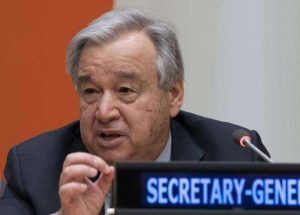Thailand is one of the oldest regions in the world where the earliest imprints of Buddhism remain institutionally strong. Deeply rooted in the Theravāda tradition, the majority of the population in Thailand continues to follow in the footsteps of the Buddha to this day. Because of the impressive number of monastics within the saṅgha, Thailand is also known as the Land of Yellow Robes. Devotees and practitioners, guided by their faith in the three treasures, continue to honor and cherish their Buddhist heritage, with its glorious culture and rich traditions from centuries past.

The arrival of the Dharma in Thailand
The history of the Buddhadharma in Thailand can be traced back to the earliest days of recorded Buddhism: that is, in the reign of Mauryan emperor Aśoka the Great. (304–232 BCE) At the end of the Third Buddhist Council, Aśoka began propagating Dharma outside of his kingdom. He took the revolutionary decision to introduce the Buddha’s teachings beyond ancient India for the first time. With the support of Emperor Aśoka, Elder Moggaliputta Tissa, president of the Third Buddhist Council, appointed nine missionaries, each accompanied by four monks, to propagate the Dharma throughout nine regions.
Out of the nine missionaries, an envoy led by two Indian monks, Thera Soṇaka and Thera Uttara, brought the Dharma to the region of Suvarṇabhūmi (the Golden Land) in 250 BCE, which would latterly come to be known as Thailand. A Thai account recorded that these noble missionary for Suvarṇabhūmi arrived in the city of Dvaravati, which became subsequently known as Nakon Pathom (Skt. Nagara Prathama). The name Dvaravati is derived from Sanskrit, and means “that which has gates.” In memory of the earliest arrival of the Dharma in Thailand, King Mongkut (Rama IV) (1804–68), constructed a massive stūpa in the city of Nakon Pathom, which is known as Phra Prathom Chedi or Prathama Cetiya (the first holy stūpa).
The growth of the Buddhist diffusion in Siam
With the arrival of Thera Soṇaka and Thera Uttara, the seeds of the Dharma were planted in ancient Thailand. Through the important relationship between Han China and ancient Thailand, Thai devotees sought refuge in the three treasures during the reign of Emperor Ming (28–75 CE). King Khun Luang Mao was the first Thai ruler who was formally declared as an ardent devotee of the three treasures. Determined to uphold the teachings of the Buddha, King Khun Luang Mao watered the seed of the Dharma, which took root deep in the fabric of Thai culture.
During the Kushan period (30–375 CE), the Dharma reached further heights of expansion. While traveling along the silk routes, members of the saṅgha were frequently assisted and protected by traders and merchants. As these business-minded people came in contact with the saṅgha, they exchanged information about culture, language, and religious beliefs. Dharma transmission along the silk routes introduced the Sarvāstivāda traditions and the concept of the Mahāyāna bodhisattva ideal. The Pāli and Sanskrit languages later influenced and became part of the mainstream Thai languages.
With the Dharma having begun its expansion outward from Kaśmīr, Gāndhāra and Bactria, the Mahāyāna tradition was adopted by devotees and practitioners of ancient Siam. The kings of the Śrīvijaya empire ruled over a Buddhist thalassocracy (maritime empire). It expanded from Sumatra (present-day Indonesia) to Surasthani (southern Thailand), and thanks to this, Buddhism flourished in the Thai region. Supported by the Śrīvijaya kings, Buddhist monasteries, stūpas, and educational institutions were established by 757. Archeological evidence from the chetiya (Buddhist stūpa) of Nakon Sri Thammarath in southern Thailand, and images of the Buddha and the bodhisattvas, reveals the initially strong presence of the Mahāyāna tradition.
Contrary to popular stereotypes, therefore, Mahāyāna was practiced in ancient Thailand and the dominance of the Theravāda tradition was not initially set in stone. This was during the reign of the Suryavarman dynasty (1002–1182), which was based in the Kingdom of Cambodia. The Cambodian presence dominated Thailand during the Lop Buri period. At that time, Indic and Sanskrit languages greatly enriched Thai languages and dialects. During the Lop Buri period, King Anawratha Minsaw (1014–77) from Pagan (present-day Myanmar) captured northern and central territories (the present-day provinces of Chiang Mai, Lopburi, and Nakon Pathom) of Thailand in 1057. When King Anawratha took refuge in the Triple Gem, he supported the propagation of the Theravāda tradition throughout his kingdom in Pagan, as well as his new Thai dominions.
The propagation of Dharma reached its peak in Thailand during the Sukhothai period (1257–1438). King Sri Intrathit (1188–1270), founder of the Sukhothai kingdom, encouraged ancient Thai devotees to observe the teachings of the Buddha. King Ramkhamhaeng (1237–98), ruler from the Sukhothai dynasty, encouraged and supported Buddhist monks and scholars in compiling and translating Buddhist texts from Pāli and Sanskrit scriptures. Through the influence of the Buddhist teachings, the rulers of the Sukhohthai dynasty sought peace and harmony throughout the kingdom. Thai devotees considered Buddhism in the Sukhothai period as the Golden Age of the Dharma.
Laṅkāvaṁsa and the revival of the Theravāda tradition
Around the time Buddhism disappeared from India, the Dharma flourished on the island of Ceylon (Sri Lanka) under the royal patronage of King Parākramabāhu (1123–86). A Sri Lankan account recorded that Parākramabāhu agreed with his Buddhist Council that it was necessary to preserve the Dharma and the Vinaya under the leadership of Ven. Kassapa Thera in 1176 CE. The Pāli language became the formal language for research and study of the Dharma in Sri Lanka.

A group of Thai monks were sent to Sri Lanka to learn about this Buddhist renaissance. On their return home, the monks were re-ordained with a revised ordination procedure (upasampadāvidhi). The new group of reordained monks became known as the Laṅkavaṁsa.
A cadre from the Laṅkavaṁsa school traveled to Thailand to visit the royal court of King Ramkamhaeng (1237–98 CE) from the Sukhothai dynasty. King Ramkamhaeng’s support of the Laṅkavaṁsa school became instrumental in spreading the Theravāda lineage throughout the land. With the advancement of the Theravāda tradition and the influence of the Laṅkavaṁsa School, Thai monarchs such as King Lithai of Sukhothai and King Borom Trailokkanath of early Ayudhya even became members of the saṅgha. It became common for Thai youth to ordain as monks, who played an important role in compiling Buddhist literature and translating texts.
Buddhism in present-day Thailand
In the Thai Theravāda tradition, the Buddhist order was categorized into two traditions (nikāyas): the Mahānikāya and Dhammayuttika Nikāya. The Mahānikāya is considered the oldest Theravāda School in Thailand, with a significant following of monks. The Dhammayuttika Nikāya is a century older and was established by King Mongkut (1804–68) of the Chakri dynasty in 1833. Mongkut spent 27 years practicing as a monk and became well-versed in the Dharma, and an expert in Pāli scriptures. While there are two traditions among the saṅgha, monks from both diligently follow the same 227 Vinaya rules from the Patimokkha in the Vinaya Piṭaka. Today, some 300,000 Buddhist monks diligently practice the Vinaya throughout Thailand.
Apart from the development of Thai monasticism, the practice of Vipassana (insight) meditation is widely practiced in Thai monasteries. Prominent Vipassana masters include: Ajahn Mun (1870–1949); Ajahn Buddhadasa (1906–93); Ajahn Maha Bua (1913–2011); Ajahn Chah (1918–92); Thannphradejphrakhun Phrathepynmonkol (1929–2018); and Somdet Buddhakosajarn or P. A. Payutto (1938–present).
To encourage Buddhist scholasticism and preserve the sacred Buddhist texts, various educational institutions were established over the past two centuries. Inspired by the super-monastery of Nālanda in ancient India, national leaders and devotees supported the establishment of several Buddhist institutions across Thailand, such as Mahachulalongkornrajavidyalaya University, Mahamukut Buddhist University, International Buddhist College, Mahapajapati Buddhist College, and Rajaburi Buddhist College. All institutions engage in Buddhist research and conduct translations of the Buddhist texts.

Today, nearly 93 per cent of Thais follow in the ancient footsteps of the Buddha. Revering the Triple Gem, Thai devotees and benefactors have constructed approximately 50,000 Buddhist monasteries throughout the county. There are about 300,000 male monks and 41,000 active monasteries. As an extension of their generous support, devotees provide daily food offerings to the Saṅgha during the morning alms-round (pinḍapata), just as the devotees provided alms to the Buddha and his monks over 2,600 years ago. The pinḍapata is one of many lasting traditions that stepped into the Buddhist heritage. Today, the Dharma, with its ancient past, remains deeply embedded in the Thai way of life.
References
Schedneck, Brooke. 2023. Living Theravada: Demystifying the People, Places, and Practices of a Buddhist Tradition. Colorado: Shambhala Publications.
Choompolpaisal, Phibul. 2019. “Nimitta and visual methods in Siamese and Lao meditation traditions from the 17th century to the present day”. In Contemporary Buddhism, 20:1-2, 152-183. DOI: 10.1080/14639947.2018.1530836.
Kusalasaya, Karuna. 1983. Buddhism in Thailand. Kandy: The Wheel Publication.
Related news reports from BDG
Santi Asoke Founder Ven. Samana Bhodirak Dies in Thailand Aged 89
Thailand Takes a Historic Step Closer to Legalizing Same-Sex Marriage
Thailand Celebrates Makha Bucha with a Display of Buddhist Relics from India














